Animation: Workout
This project shows one way to animate an object in Etoys. Imagine you "teaching" a stick figure to do a jumping jack. You will Invent a sequence of images to create the illusion of movement. This may Inspire you to create an entire workout routine.
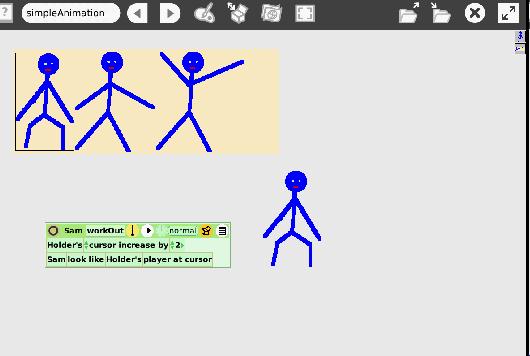
In this project we use:
A set of painted objects, Holder, Holder's cursor, "Holder's player at cursor", create a composite tile, "object look like-dot".
Project
The animation effect is created by iterating through a collection of images. The first image is the opening state of the movement, and each one in the sequence is a step closer to the final state. The rapid movement from one image to the next creates the desired illusion of movement.
Instructions: Open Etoys and click on the cloud that says Make a Project
1. Create the set of images you need for the change you wish to illustrate. Images can be painted, imported, or a combination of the two.
Important: when painting, make each of the images a different object, using a different paint window. Also, the objects in the supply bin do not work for this purpose, so do not use them.
2. Drag a Holder from Supplies and then drag and drop your images into the holder in the order you wish them to appear.


3. Paint a new object that will later change to look like those in the holder. A simple colored spot will do. Rename this "spot" to be more descriptive and meaningful to you so that when you look at the scripts, you know what they are referring to. In this example I used "Sam" (which is better than Sketch4).
4. Open the spot's (Sam's) viewer and open its graphics category. To do that, hold down the cursor on the word "basic" in the viewer and then move down the list and click to select "graphics" from the names that appear.
5. Drag the tile: "Sam look like dot" out of the viewer and drop it. A script editor will open.
6. Open the holder's viewer.
7. Select the viewer's "collections" category (see #4 above) and find the tile "Holder’s player at cursor". Drag and drop it to replace the box in the script where the word "dot" is (A green frame around the word "dot" will let you know you are in the right place). By doing this you have just told the spot of color (Sam) to look like the image in the holder where the cursor is currently located. This will be the image in the boxed frame.
8. In the Holder's viewer, drag the tile: "holder's cursor <--1 by its white assignment arrow and add it in to the script.
Hold down the cursor on the word "cursor" in the script and choose "increase". Make sure the increase numerical value is 1. Change the name of the script to "workOut".
9. Change the name of the script to: workOut.
The script looks like this:

Click on the clock to make your animation run.
To change the speed of the animation, (the pace of the script's ticking), hold down the cursor on the clock icon and choose a different number of ticks per second.
To make the holder invisible, (to "collapse" it), get its halo and click the circle (collapse icon) on its upper left.
This project, Simple Animation, can be found at: http://etoysillinois.org/library?sl=2131
More Inspiration
An animation of flying geese at: http://etoysillinois.org/library?sl=2133
An animated overhand knot can be found at: http://etoysillinois.org/library?sl=475
An animated blue guy using still camera shots at: http://etoysillinois.org/library?sl=2134
A small fantasy for three food cans at: http://etoysillinois.org/library?sl=2135
A visualization of life cycle of bacteria at: http://etoysillinois.org/library?sl=1842
Book Sprint Experience
The Squeakland Education team has been in existence since 2005 and we have established very strong bonds through our weekly online meetings and annual conferences. We started our own book sprint to write a reference manual and devoted a week of intense writing by several people from the Squeakland community. We filled the manual with a huge amount of valuable written and graphical material. However, we didn't completely finish both the content and the organization. So we were elated about our selection to come to the doc sprint at Google. Now that we have participated in writing a book Learning with Etoys: Imagine, Invent, Inspire, we see the value of being in the same physical space. Google provided a fantastic physical space. Adam Hyde from booki Floss Manuals was brilliant in focusing the participants on the process and monitoring our project. Allen Gunn directed an sizzling unconference, where we wrote up topics we thought were needed to be successful in the doc sprint and magically organized breakout sessions for the afternoon - fun fun fun. Thank you to Carol Smith for the great organization. The total experience was great.

In the photograph from left to right: Stephen Thomas, Kathleen Smith, Rita Freudenberg, Avigail Snir, Randall Caton, and Kathleen Harness
Inspired by Calder's Mobiles:
Imagine Art in motion. It can be found in dance, in music and in sculptures that are affected by machines, or wind or touch. Alexander Calder created many mobiles; some were suspended and some that were anchored to the ground. The shapes in a mobile are suspended from wire. In this project students Invent mobiles by painting shapes that appear to be suspended from wire and using script commands make the mobile move when it is touched. Calder may Inspire them to be first computer mobilest.
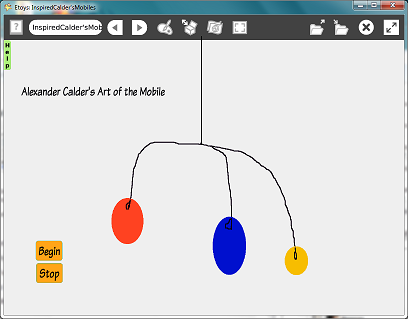
In this project we use:
Paint Tools, Halo Handles, Text, Width Length,Tests Category,Normal Ticking, Button Fires a Script
The project also uses the Scripting category of tiles and they will be explained in the lesson.
The Project
http://etoysillinois.org/library?sl=2137
To begin, open Etoys and click on the cloud that says Make a Project:
Be inventive; use the Paint Tools to be an artist and paint shapes with your favorite colors. Be sure to make them look like they hang from a wire.

To quit the paint tool when you finish drawing click on Keep.
Now let's make this painting move like Calder's mobiles. We will use many of the Halo Handles useful tools. Click on the small aqua color dot that looks like an eye, to open a set of script tiles in a new pane.
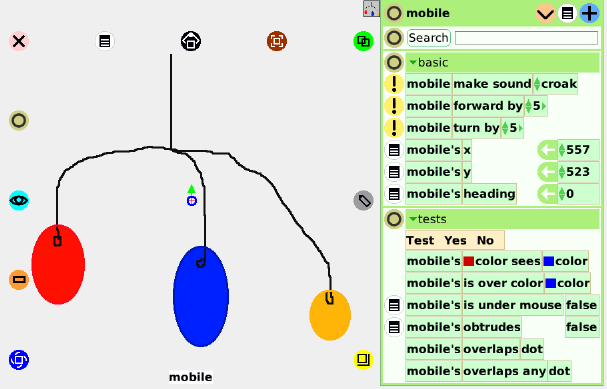
Change the name of your sketch to "mobile". Look in the new pane, the Viewer, and you will see all the tiles for the sketch you just named are now called "mobile".
We can make the mobile's dimensions change to make it look like it moves in space. The first script will make the mobile shrink; the second one will make it grow. Click on Basic and select the More Geometry category.
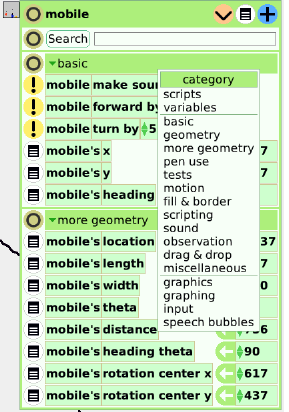
Drag out the "width" tile and drop it in an empty part of the window. The new box around the tile is called a Script Editor. The tile shows us how wide the mobile is but we can make the size change by clicking on the small black arrow to open a menu of options.
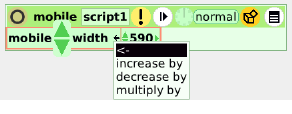
Choose decrease by, rename the script, and experiment with the number to see how different numbers work. Click the exclamation mark to run the script one time. Use the same set of steps to make a script that increases the width. Give each script a meaningful name. You will have two scripts that look like these, but you might have different numbers. The green circle with the clock is a button that starts and stops the script.
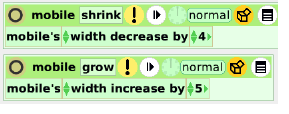
Now let's make a reset script. Drag out the "width" tile and the "length" tile and put them in one script. Remember what your mobile looked like before you started experimenting with it and adjust the width and length in the tiles to resize it. When it looks right, change the name of the script to Reset.
One last thing to do with the reset script is to select its white Menu option: button to fire a script. The little button is smaller but does the same work as the script. It will look like this small aqua one but you can change the size, the label and the letter style. Experiment with the options in the button's white menu. My finished button looks like this big orange one.

The next step is to make a script that will start and stop the shrink and grow scripts. This example uses a test statement to cause one script to work if the mobile is under the mouse and if it is not under the mouse the other script will be ticking. The test is found in the Test category in the Viewer.
There are no Quick Guides for the Scripting tiles but they are useful for this project, and many other projects. In the Scripting category find tiles with "start" and "pause". The tile ends with the words " empty script" but, if you have been naming your scripts as you created them, clicking on the words "empty script" will open a menu that lists all of your scripts . . . by name.
The finished script looks like this. Name this script too.

The last script for this project is one that controls when the motion script starts. Click on the white menu in the top of the motion script and choose: button to fire a script. Make the new button look like your Reset button and change its label using its white menu.
Now let's give the project a title. Open Supplies in the Navigator Bar and drag out a copy of the Text. Text is a box that you type into and fill with the information or directions for your project. Just like in word documents, the text's font, color and style can be changed. There are three special icons in the Halo for Text: pale green pale pink and brown.

Experiment with your text's options until you like the way it looks and then think about where in your project window is the best place for it. Do you want it near the buttons or above the mobile, or someplace altogether different? Your project shows the results of all the decisions that you have made.
As the author of an interactive art work you have a responsibility to the people who visit your project to make it ready for them. Throw away trash cans and other objects you do not want visitors to see. Correctly spelled words make a good impression. Click on the little tabs that open Viewer panes and collapse them so they are out of view of visitors. If everything looks right, Save the project and share it.
More Inspirations
Are you inspired to learn more about Alexander Calder? Look at images of his work in books or on the internet.
Etoys projects inspired by other famous artists are available. Here are links to two sets of projects you might enjoy.
Kandinsky Inspired: http://etoysillinois.org/library?tags=Kandinsky%20Inspired
Miró Inspired: http://etoysillinois.org/library?tags=Mir%C3%B3%20Inspired
Alexander Calder (July 22, 1898 – November 11, 1976) was an American
sculptor best known as the originator of the
mobile, a type of
kinetic sculpture the delicately balanced or suspended components of which move in response to motor power or air currents; by contrast, Calder’s stationary sculptures are called stabiles. He also produced numerous wire figures, notably for a vast miniature circus.
http://en.wikipedia.org/wiki/Alexander_Calder
Camouflage
Camouflage is found everywhere in nature, as it is the tendency for many animals to stop still when alarmed. This project will help students to see a plausible explanation of why animals “freeze” when threatened. Can you Imagine how animals behave when in danger? To get an understanding of this, you will Invent an animal and it's environment, so that it can camouflage and describe it's behavior and watch. Let this project Inspire you to create puzzles or moving illustrations.

In this project we use:
Halo, Naming, Painting Tool, Scripting, increase by
Project
(original idea by Alan Kay)
First, open a new project. You can do so by opening Etoys and clicking on the lilac cloud that says "Make a new project". Now you have the whole Etoys world at your disposal. Let’s start with painting some grass and then a grasshopper, using the same shade of green for both.
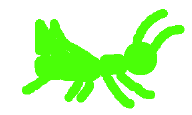

How to paint

To paint objects in Etoys, there is the painting tool in the navigation bar at the top of your window. Click on the icon shown above and you will get a new sheet of paper and the tools to paint on it.
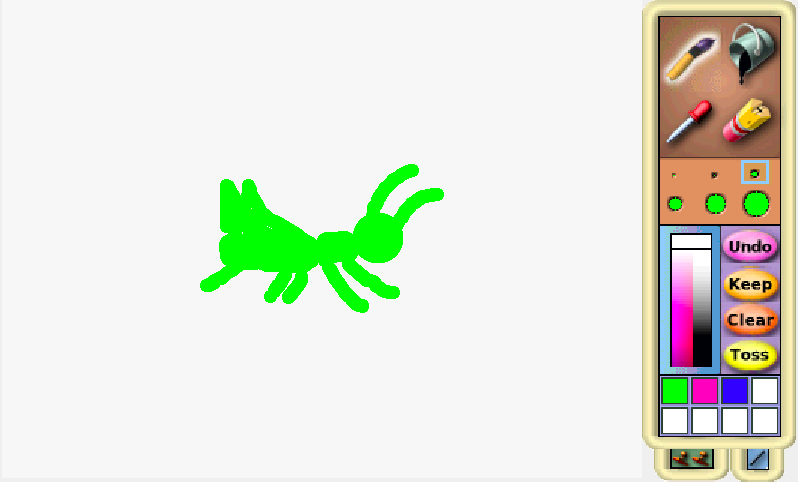
Every time you click on the icon, you will open a new sheet and start a new painting. You need to make two paintings here, one for the grasshopper and one for the grass. Make sure you quit the painting tool when you finish a drawing.
You can find out how to use all the elements of the painting tool in the Etoys Quick Guides - Paint Tools and get an overview in the Getting Help chapter of this book.
The drawings you made are in fact objects you can pick up and move around. They will be called "sketch" until you give it another name.
How to bring up the Halo and name a sketch
To give your drawing another name, you need to bring up the Halo for this object. You can do this by right-clicking on this object (cmd-click on a Mac). Now you see a number of colored icons around the object and the name of the object on the bottom. Click on "sketch" and type the name you want.
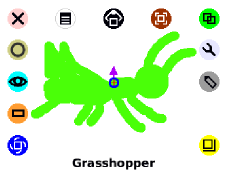
Now put the grasshopper in the grass, and you can see right away why its green color might help it escape from birds and other predators that might want to eat it.

Now let’s write the simplest of scripts for the grasshopper to get it to move sideways in the left-right direction (the official name for this direction is x). The world in Etoys is a two-dimensional coordinate system with x being the value of the horizontal position of an object (starting with 0 at the left side).
How to write a script
In Etoys, writing a script actually means to compose a script using the tiles available for the objects. You find the tiles for each object in it's Viewer. Bring up the Viewer for an object by clicking on the blue eye icon on the halo. The viewer for the grasshopper will look like this:
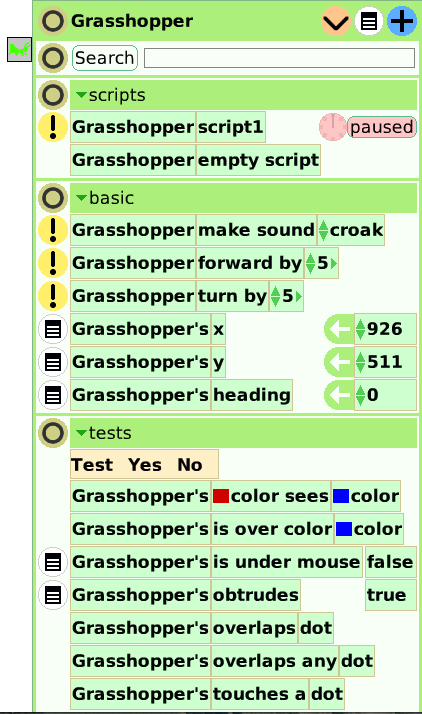
You'll see the "Grasshopper's x tile" under the heading "basic" (which stands for category basic) in the upper half of the viewer.

Drag the tile onto the Etoys world, using the white arrow, and it will create a script editor around it the moment you drop it. If that doesn't happen, try again and make sure, you grab it at the white arrow shown in the image above.
Now you can change the command to let it perform the action you want. Clicking on the white arrow in the command tile will bring up a menu of operations where you choose "increase by" to move the grasshopper from left to right. You can change the value for "increase by" by clicking on the number and typing in another one. Find more help in the Quick Guides - Script Tiles - X and Y Tiles.

Now run the script by clicking on the clock in the top line of the script editor. The script will repeatedly execute the command until you click the clock again to stop it.
All of a sudden you can see where the grasshopper is, and so can most other animals. Now you have a little insight into why animal vision is almost always better at detecting motion than in seeing fine details – and also, why animals might want to keep still when threatened.
When you are finished, you'll want to save your work for later use or to show it to your friends and family. You can also make different versions based on the ideas you have.
How to save and load

The button you see above is the "publish" button. Find it in the navigation bar and click it. A dialogue box will open. It asks you to put in a name for your project (to make it easier to find it again later). You can put in your name in the author field, a description and other information if you want. Click "Ok" and you will get another dialog box where you can choose the destination for your project. The default location is the Etoys folder on your computer. It is strongly recommended to save all your projects there, because this is the folder which will be presented by default when you are going to load a project.

To get a project out of your folder, click the "find" button on the navigator bar. It will present all the projects you have saved so far in your Etoys folder. Select the one you want and click "Ok". The new project will open in Etoys. To get back to the previous project, use the white arrows in the navigator bar.
For more information about loading and saving from different locations etc., look at the Quick Guides Navigator Bar - Keep Find Projects.
More Inspiration
You can find the project used in this chapter here: http://etoysillinois.org/library?sl=2147
If a creature like a grasshopper lived in a desert environment, what color would you expect it to be? Can you create a project for that?
With the things you learned in this chapter, you can do many wonderful paintings with moving objects in it.
Or you can create a puzzle as you can see here in Avigail Snir's projects for students from 1st grade and up http://etoysillinois.org/library?sl=760
Training Your Robot
Imagine kids delighted at the opportunity to "program" and control each other, their parents or a teacher. They will use that delight to help them Invent a robot that draws polygons. In this chapter we will begin with an exercise completely outside the computer to learn geometry and build knowledge about how to program a robot. This will Inspire them to use their programed robots to create string art.
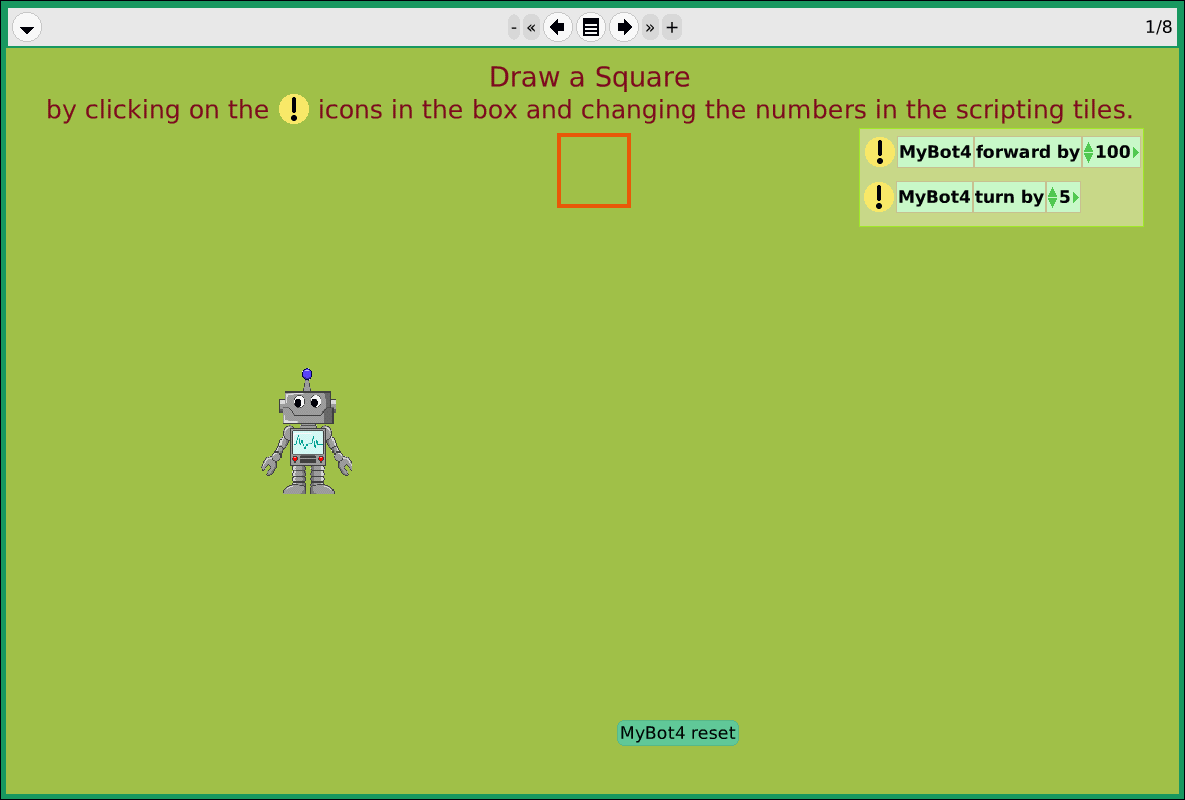
In this project we use:
Scripting, forward by, turn by, repeat
Optional: Pen Size, Pen Color,
Optional: Paint, Tiles: look like, Playfield's pen trail graphic
Quick Guides: Script Tiles -> Playfield Trail
The Project
Kids programming Kids (and parents)
The following activity can be done having kids program each other and/or having them program their parents or teacher. An example of how to do this can be found http://drtechniko.com/2012/04/09/how-to-train-your-robot/
Below is a sample worksheet.
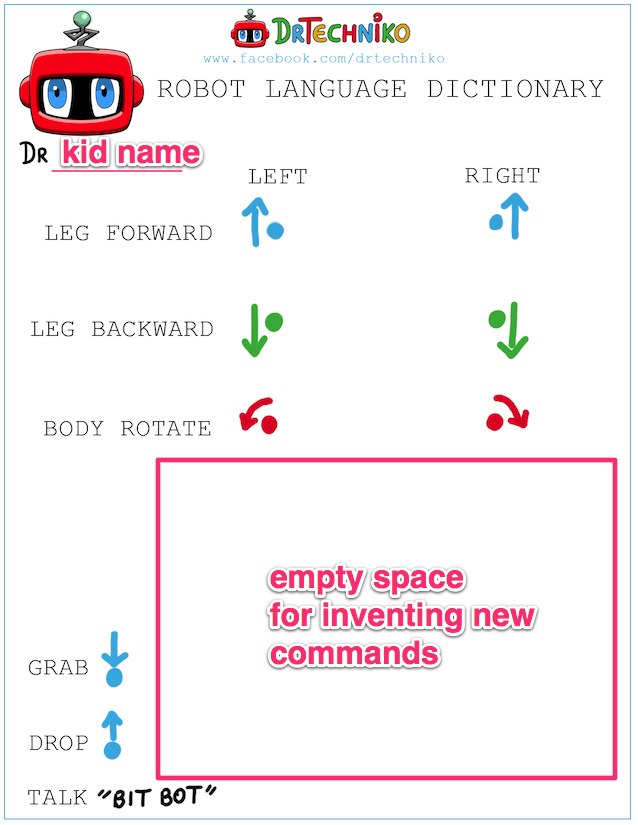
Try this with the kids, having them program each other to:
- walk a square
- walk a rectangle
- go from one part of the room to another and pick up something
From Programming each other to Programming Etoys
Once the kids have programmed each other, now we will try and transfer some of that knowledge to programming a Robot to constructing Polygons in Etoys. This project will begin with a pre-built template which should be downloaded at: http://etoysillinois.org/library?sl=2144. The project can be used in classrooms with English and Spanish speaking students.
Open the project in Etoys.
In this project kids are provided with just three scripting tiles with which they can create all the shapes:

On the first page the kids are asked to draw a square by:
- clicking on the
 icons and changing the numeric values in the forward by and turn by tiles
icons and changing the numeric values in the forward by and turn by tiles
Kids can "reset" their drawings by clicking on the  at the bottom of each page.
at the bottom of each page.
On the rest of the pages we will ask them to draw the polygons, by creating scripts. To create the scripts they click on the scripting tiles in the box and drag them into the empty script on each page.
While they do this have them fill in a chart like the one below or the one in the project:

Some kids will be able to start quickly on their own and others will get stuck. The following are some tips to help kids when they get stuck.
Learning to Debug:
The goal is to get kids to "Just Do It" and start trying things on their own. They inevitably will get stuck and have to debug their programs. This is good, one of the skills we are teaching is debugging and persitistence. Below are some sample problems kids have run into and suggestions on how you can help them.
If their robot disspears off the screen (which will happen) have them click on the  button.
button.
Have them explain their code to someone else. Often even with very experienced programmers, once they start explaining the problem to someone else they figure out the problem for themselves, then thank you for being brilliant and such a great help. Its up to you if you want to let them know they really solved it for themselves and they are the brilliant ones :)
Have them read their code out loud EXACTLY AS WRITTEN. We often get confused between what we intended the robot to do and exactly what we told it to do. To quote an old Chicago politician "Print what I meant, Not what I said!!!"
As they read the code aloud, walk through what the robot will do based on that specific instruction AS WRITTEN either in their minds eye, on a piece of paper with a pencil or with some other object like a toy car.
Ask them to step away from the computer and walk the shape. Then ask them to say out loud specifically what they are doing at each step using "forward by" and "turn". This can help them become more aware of their body knowledge and help them transfer that to their program.
Also ask them to try the following:
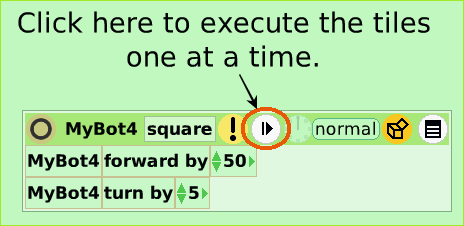
This will executes each tile in the script one at a time. It forces the user to "slow down" and look at the results of each step. One can use this in combination with reading the code out loud. One reads the line that is about to be executed, then click the step button.
 or
or 
This will allow them to see what happens when the whole script runs.
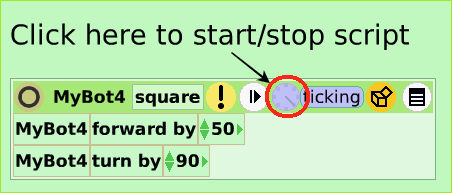
You may want to change the script speed, it can open new insights and help visualize what the script is doing.
To change the speed (in # of ticks per second, or # of times the script runs each second) simply click on clock in the script and hold the mouse down:

A pop up will appear and you can select your speed.
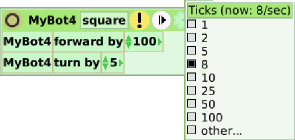
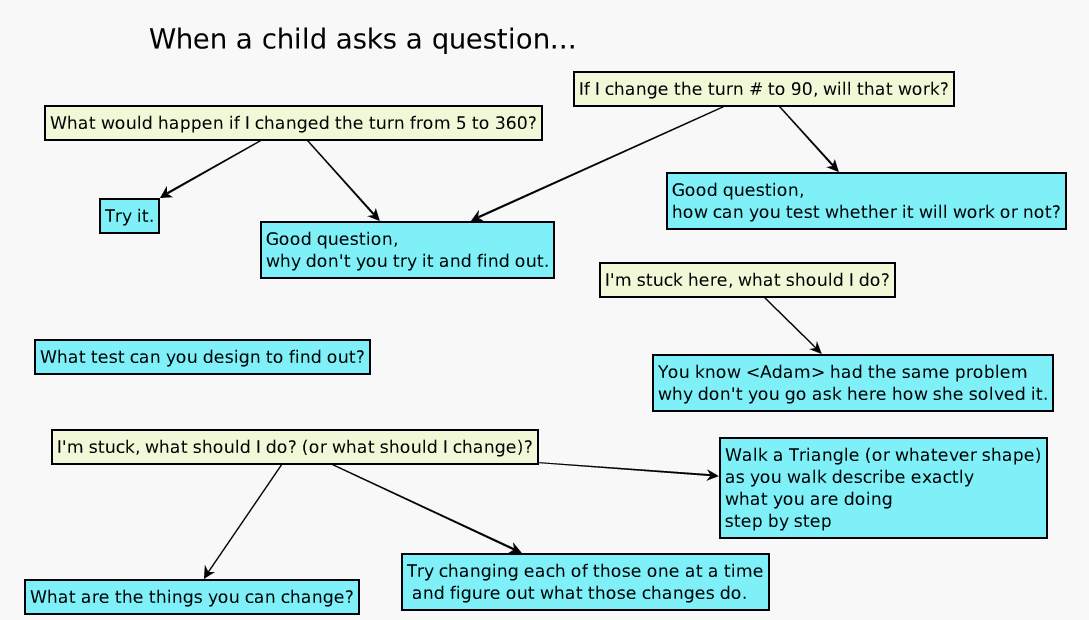
Questions for reflection:
- Find one or more people who created a script to draw a square that did it differently from you?
- What was different?
- What was the same?
- Look at the scripts you used to create a Square and to create a Rectangle and identify:
- What is different?
- What is the same?
- For those things that are different, does that difference matter? How does it matter?
- Look at the chart you filled in (Shape, # Sides, # Vertices, Angle (aka turn by) and <# Sides> * <Angle>. What patterns do you see?
- Look at all your scripts and after identifying, what's different (that matters) can you create "One Script to Rule them all?" In other words can you create one script that creates all the shapes?
- Hint1: Use a variable
- Hint2: Look at the patterns you noticed in your completed chart.
- Look at the following:

- What's the same?
- What's different?
- Do the differences matter?
- Look at the following:

- What's the same?
- What's different?
- Does the differences matter? If so, how?
- Look at the following:

- What's the same?
- What's different?
- Does the differences matter? If so, how?
- Look at the following:

- What's the same?
- What's different?
- Does the differences matter? If so, how?
- Look at the following:

- What's the same?
- What's different?
- Does the differences matter? If so, how?
- Look at the following:

- What's the same?
- What's different?
- Does the differences matter? If so, how?
Inspire
Besides regular polygons, here are some shapes people have created using pen trails, forward, turn by, repeat and pen color:
Also see if you can create the 39 shapes below from Barry Newell's Turtle Confusion http://constructingmodernknowledge.com/tcbook.pdf. Make a poster of these shapes and hang them in your class.

Decorate your Tree: Another Way to Animate
Exercise your aesthetic sense. Imagine decorating a tree and even designing your own animated decorations. You can start by picking existing ornaments to decorate a tree. Next Invent your own animated ornaments. Finally, Inspire your friends to create their own ornaments. Look at others' scripts and work together to improve your ornaments and create new ones.

In this project we use:
text, book, flap, object catalog, test, color, border color, color sees color, forward by, turn by, arithmetic, random, animation, paint tool
Project
Begin by downloading the project from http://etoysillinois.org/library?sl=2140. The project can be used in classrooms with English, Spanish and German speaking students. If you are teaching a foreign language, you can use this project because you can easily change between languages. Click the flag near the middle of the navigation bar at the top for a drop down menu to change languages.
Learners should look at the already decorated tree on the first page and imagine how they would decorate their tree. Send them to the next page to learn how to decorate your own. The existing ornaments are in the Decorations flap at the bottom of the project. Click on the flap to open it. Click on an ornament and it will stick to the cursor. Drag the ornament to the desired position and click to let it go. New ornaments can be drawn using the Paint Tools.
If the newly created ornaments are dropped into the open Decorations flap, then duplicates can be dragged out as needed. A flap is closed by clicking the flap. To re-size the Decoration bin, drag the flap up or down. It's time to imagine and decorate the tree on page 4 - or draw your own tree on page 5 to decorate.
As an aside, your students might want to create their own flaps - it's fun. Drag an Object Catalog out of the Supplies.
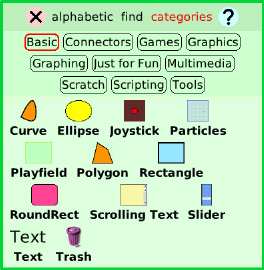
The Object Catalog has a lot of fun things to explore in addition to creating flaps. Each of the buttons, like Basic outlined in red above, gets you to a different category of objects. To find the flap object, click the Scripting button.

Drag the Flap object out onto the world and it will attach to the bottom edge. You can put things into this flap and close it up to get them out of the way, but they won't be duplicated. To change the flap's property, get the flap's Halo and select the white Menu button. There are many options, like cling to edge (to move the flap to the right, left or top), change tab wording (to rename the flap tab), and make the flap a parts bin. Selecting this box means that any object (including an object with scripts) put into the flap will be duplicated when you drag it out. Note that you can also get a Flap from the Supplies bin.
Now it's time to invent animated ornaments. To create ornaments that flash, go to pages 6 and 7 for an overview. Start with a Circle, Curve, Ellipse, Polygon, Curve, Rectangle, RoundRect, Star or Triangle object from the Graphics category of the Object Catalog. The objects mentioned above all have a "color" category with red, green and blue tiles that tell how much of each color is in the object. By making the values of red, green and blue random the round ornament color flashes. Create a script for your object and go to the "color" category in the viewer. Drag out a tile for each color and the border. Be sure the red box surrounds the color and the number at the right. In a similar fashion, drag out a tile for the border color from the "fill & border" category. Your Script Editor should be similar to the image below.

To make the red tiles value random, click on the gold box icon second from the right at the top of the Script Editor and drag a random tile on top of the number value in the red tile. Change the number in the random function to see the effect. Do the same for the green and blue tiles.

If you make the border color the color of the flashing star, the border flashes. You can get a tile for the star's color from its viewer or it's halo to drop on the border color tile's color value. Look under Halo Handles and Script Tiles in Help to reinforce and learn more.
More Inspiration
Go to page 8 to see another way to animate your ornament. The tiles used have been covered previously. Have your students work in groups to figure out how this script works. From their thinking and discussions, they should be able to inspire one another to create better ways to animate their ornaments.
Then on page 9, students are led to another way to animate. have them continue discussions about the new way and inspire each other. Pages 10 and 11 are blank for students to work on their inspirations. They can add more pages as needed.
Motion: Follow the Bee
Can you Imagine a bee flying in a beeline? Try, because this is the most simple motion. In this project you will eventually Invent a bee who will fly on a line of your own making. You may even be Inspired to create other paths your bee might take.
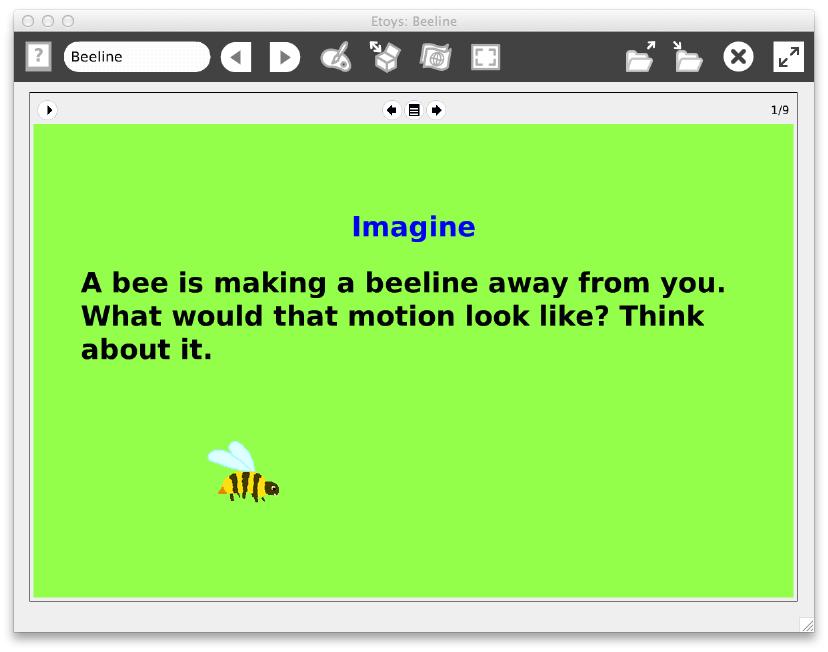
In this project we use:
text, book, watcher, variable, graphing objects, Start Script, Stop Script, forward by, turn by, mouse down, animation, arithmetic
Project
Begin by downloading the project from http://etoysillinois.org/library?sl=2142.
By following the bee, learners can get a basic and kinesthetic sense of constant velocity. They can explore further by graphing the motion and writing their own script to move the bee.
They will start by exploring the motion of an existing bee. Bees, like all objects, have a position in space. If they are moving they have a velocity. Students will learn about these concepts and understand them more deeply by recording and graphing data regarding the bee's motion. After analyzing their graphs, they will invent the motion of their imagined bee. Finally, they will look at each others' projects and inspire each other by suggesting improvements. They can take their project and challenge friends and family to fly their bee straight.
Vocabulary the students will need:
Position (page 2) is where you are in space. In this activity we will be interested in the back and forth position of the bee. We often call that the x direction when its horizontal. If your students click on the bee, the bee will stick to the cursor - click again and the cursor let's go. They can move the bee back and forth. They should notice the x value change in the Bee's x watcher for a kinesthetic and visual input.
Velocity (page 3) is how fast you move through space.
On page 3, learners should click on the bee to start it moving, and click on the green background below the text to pause the bee. Next they should change the velocity in the "bee's v" watcher to explore different velocities. They should try negative ones. By using the two watchers on this page, challenge them to get the bee back when she gets to the edge.
On page 4 they should record the data (time, position) in and two column chart, as the bee moves across the page. They should not change the velocity. They again click the bee to start and click the green below the text to pause and record data - click the bee to continue. Each pair of data points should be a time from the "Bee4's t" watcher and the position from "Bee4's x" watcher. They should record at least 10 points. To start over and record new data, set the time and position to zero.
On page 5, students will plot their data. Once they have completed the plot, you should put them in small groups to discuss the following questions:
1. What should your horizontal and vertical axes represent to get all of your data points on the graph?
2. Describe the pattern of the data plotted on the graph.
3. What is special about the pattern of the data plotted on your graph?
4. Why do you think the data have the pattern you observed?
Here is where your students invent. Have them create a script to have the bee move similar to the way she moved on pages 3 and 4. To get them started have them go to page 8 where they will find the following the directions:
Take tiles from the holder on the right and drop them into the Script Editor at the left to make the bee move like it did on pages 3 and 4. You may need more than one tile in some cases. There are several ways that work. Find as many as you can. Check out Script Tiles in help at the upper left. Enable pen trails to better see the path of the bee.
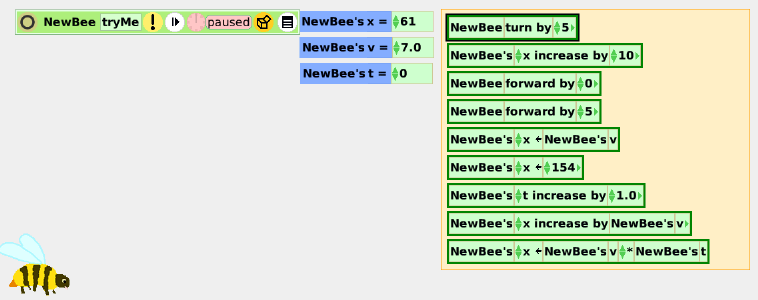
More Inspirations
Next your learners should create another script to make the bee follow their plot line. They can think out of the pink box above. Give them an opportunity to explore each others' scripts, suggest improvements and provide inspiration. Let them imagine, invent and bee inspired from the task above to create new scripts to fly the bee differently.
Fractions
Imagine a fraction. Does it raise the hair on the back of your neck? Visualizing fractions makes them easier to understand. Invent visualizations of fractions and Inspire others to understand fractions more deeply.

In this project we use:
text, sector, viewer, Sector's angle, Sector's radius, Text's numeric value, variable
The Project
Begin by downloading the project from http://etoysillinois.org/library?sl=2143.
The focus of this project is visualizing fractions. The sector object allows creation of a slice of pie that represents any fraction of the pie desired. On page 2 of the book you click the sector tool at the upper left to create a slice of pie. Then check the "sector" category in the sector's viewer to change the angle and radius of the slice (see help at the upper left to review the Viewer under Halo). After visualizing fractions with the sector tool, students move on to page 3 for the invention part of the project. They should create fractions using the text tool from the supplies bin. They may just write the fractions in a single text box, but they will realize later that, to program, they must really have two text boxes, one for the numerator and one for the denominator.
On page 4 the students are asked to create a script that shows a visualization for any fraction they enter into a numerator and denominator of the fractions shown. There are many ways to do this. They should work on page 5. There is a solution on page 6, but don't have your students look until they have made a good attempt. They may struggle with this, but they will be learning.
On page 6 there is one solution to the task. Enter any numbers into the numerator and denominator of the fraction to see its visualization. Keep the fraction less than 1. Why? Discuss with them why the fraction must be less than 1. The maximum fraction the sector object can visualize is the whole circle and that represents 1. After students have written their own scripts they should compare them. Finally, your students should open a Viewer on the sector object and drag out my script. Have your students group and try to understand my solution. Then they should compare their solutions with mine.

NOTES:
The numerator and denominator are text objects. They can have variables of type numeric. The script gets the numerator and denominator needed to create a fraction. The fraction of 360 degrees (value 1 for the whole of the pie) is visualized by the sector object. The sector is a visualization of the fraction.
Now (pages 7 and 8) have your learners create a script to show a visualization of adding two fractions. Work in groups. Listening to and learning from each others' views is a valuable skill. They should be reminded of this as they work. After a fair attempt they can look at my solution on page 9.
On page 9 students should enter any number into the numerators and denominators of the fractions for a the visualization of addition. They should keep sum of the fractions less than 1. Why? Again discuss this point with your learners. Again, you should have your students open Viewers to analyze my scripts. Have your students group and try to understand my solution. Then they should compare their solutions with mine.
More Inspiration
Write scripts to visualize mixed fractions that are greater than 1. Write scripts to visualize subtraction, multiplication and division.
Getting Help
To begin using Etoys you will need to go to http://squeakland.org and download the software. If your school does not allow a direct download to the machines, there is an option to download Etoys to Go and have it on a USB drive. It is a free and open source application. A copy of the license to use the software is provided below for you to show the technology person in your school.

For additional help to download the software you may go to the Etoys Reference Manual at: http://www.gosargon.com/EtoysReferenceManualV0.8.pdf. The information starts on page 10.
User Information Help:
The Etoys Quick Start Guide below shows the names of many commonly used objects and tools:


Using the Help button on the left of the navigation bar you can access the Quick Guides:
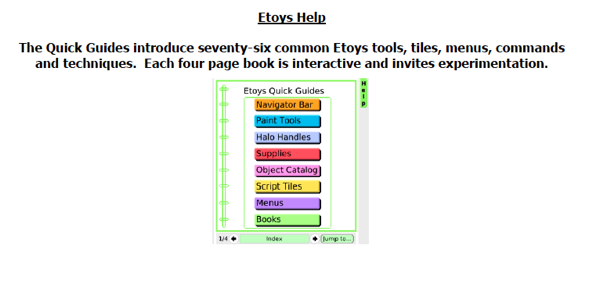
The Quick Guides will further explain all of the topics below:
Halo Icons
The colored icons that surround an object allow for manipulation and change to that object. Every object has a set of Halo Icons. Right click on any thing to reveal its icons. Each icon is supplied with a balloon describing its function. Halo is also a category in the Quick Guides .




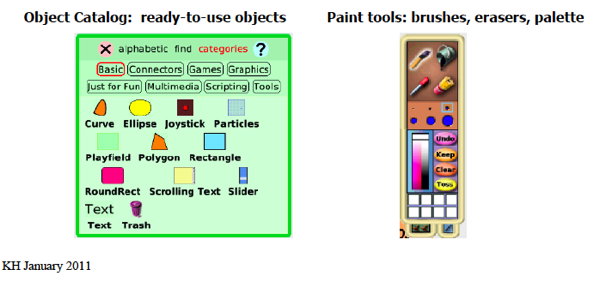 Additional Resources:
Additional Resources:
Squeakland: http://squeakland.org This is the home site for Etoys. There is a link to download the software at the top of the page.
Etoys Illinois: http://etoysillinois.org Here you will find sample projects done by students and links to many resources. You may want to spend sometime making yourself familiar with all this site has to offer.
Explore and Learn: http://www.pcs.cnu.edu/~rcaton/squeak.html Here you will find projects created by Randy Caton for grades k-14.
How to Videos: http://www.youtube.com/playlist?list=PLFDD4D8876FC2E6FC Here you will find 18 short videos on common topics.
Minute with Mr. Steve: https://www.youtube.com/user/sthomastt?feature=mhee
Etoys Users Manual: http://www.gosargon.com/EtoysReferenceManualV0.8.pdf This is a 108 page .pdf file of the full user's manual.
Illusions
Can you Imagine that what you see is not what is there? Illusions furnish many examples of “the world is not as it seems”, and many of them are quite startling when done dynamically. When we look at a scene, we think we are seeing the lights and shades and colors accurately, but in fact, both our lower level and higher level mental mechanisms are reformulating what our retina senses. For example, the apparent brightness of a gray tone is quite conditioned by the brightness of the background around it. We can show this both statically and dynamically. Invent some illusions using the computer in this chapter and let them Inspire you to challenge your senses in different ways.

In this project we use:
supplies bin, rectangle, coloring, writing a script, increase by, heading, composting tiles
Project
In this project we use ready-made Etoys objects which you can find in the supplies bin, change their color and write a script to move them. So let's start with the supplies.
How to use the Supplies Bin

First, find the Supplies icon on the Navigation Bar and click it. This will open the Supplies bin, which provides you with a variety of ready-made objects to use in your projects. Also, there is the Object Catalog in the Supplies, which you can drag out to find many more objects to use.
For this project, we'll use the rectangle, which you can find directly in the Supplies. Drag it out on your screen.

We want to change the color of the rectangle to be a neutral gray.

How to use the rectangle
To change the color of your rectangle, bring up the halo of the rectangle. You might notice, that you get a purple icon here. It is only available for certain objects and can be used to change the color of an object. Clicking the purple halo icon transforms your cursor into an eyedropper. Move it over the color you want and click to choose this color. Choose a neutral gray.
The rectangle still has a black border, for our project we need to remove it. You can do this by bringing up the halo for the rectangle, clicking on the white menu icon and then changing the border color to the same color as the body of the rectangle.

When you have finished this, copy the rectangle, using the green icon of the halo. Now you have two gray rectangles.
To create the contrast illusion, you need to get another rectangle out of the supplies. Change it's size to become bigger using the yellow halo icon. Click on the yellow icon and hold it while moving the mouse until it is the size you want.
Color the big rectangle black. Then copy it and change the color of the copy to white. Now move the two smaller gray rectangles: one onto the black rectangle and one onto the white one as you can see in the picture below.
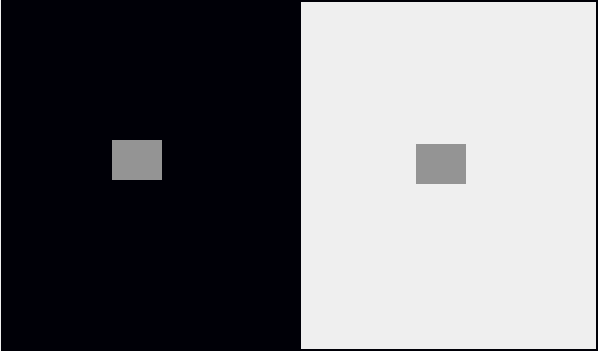
You can already see that the right hand rectangle on the white background looks darker than the copied rectangle with the same gray color on the black background. This is called the Mach Illusion, and it serves to help animals to see things that are almost the same color (because it makes the difference more apparent).
When clicking on the big rectangles, it can happen that they stick to your mouse and suddenly are in front of the smaller ones. To find the smaller rectangles again, just move the bigger one away to find the rectangle underneath.
We can also make a dynamic version that seems to change colors, and also proves that the two squares are the same color. To do that, we write a script that moves the rectangle from the black background over to the one on the white background.
Get the halo for the gray Rectangle on the black background (named Rectangle1 in the example project) and click on the blue eye to open the Viewer. In the viewer, you'll see the tile "Rectangle1's x".

Drag the tile onto the Etoys world, using the white arrow, and it will create a Script Editor around it the moment you drop it. If that doesn't happen, try again and make sure, you grab it at the white arrow.
Now you can change the command to let it perform the action you want. The world in Etoys is a two-dimensional coordinate system with x being the value of the horizontal position of an object (starting with 0 at the left side). In order to move the left gray rectangle towards the right one, we need to increase it's x value. Clicking on the arrow in the command tile will bring up a menu of operations where you choose "increase by".

The value in the tile means how many pixels the rectangle's x will increase in each run of the script. Choose "1" to let it move slowly. You can change the value by clicking on it and typing in the number you want.
Start the script and watch how the rectangle moves over from the black to the white side and finally reaches the other gray rectangle. You'll see that it has indeed the same color.
Now let's do another kind of illusion.
The basic idea is that the same sized object placed on a picture of railroad tracks will look larger when placed higher where the tracks appear narrower. The mental calculation is that things of a certain visual angle in a context that whispers “farther away” are perceived to be larger. Here are two rectangles placed on a picture of railroad tracks.
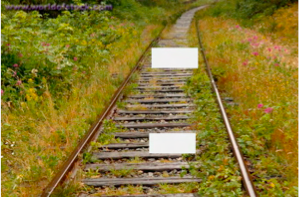
We can make a dynamic version of this illusion in Etoys, and also learn something about angles, negative numbers, and how much convergence is required to manifest the illusion.
Get a rectangle out of the supplies and color it. Give it roughly the shape as you can see in the picture of the railroad tracks. Copy it, because we need two rectangles with exactly the same size and shape.
Now we need to create the tracks. Get another rectangle from the supplies. Make it tall and skinny, using the yellow halo icon and then copy it. Arrange the rectangles as seen in the picture below.

What we want to do now, over and over again, is rotate the left track the opposite direction but same amount as the right track. To change the angle of an object, in Etoys we can change its heading.
How to use heading
Open the viewer for one of the tracks. In the basic category you can see the tile with the heading set to 0 by default. Go and change that number in the viewer and see what happens to your object. Try setting the heading to 90 and watch your object.
You can also do it the other way around. Turn around your object and watch the number in the heading tile. Drag the blue spiral on the halo around to turn the track around. This will give you an idea what heading means.

Did you discover that the number for heading is in degrees? As you can see from the explanation above, the direction of one track depends on the direction of the other. Here we need to composite an assignment using tiles from more than one object.
How to composite tiles
Open a viewer for all the objects you need tiles from. For our example we need the viewer for track1 and track2. We want the heading for track1 being always the "opposite angle" of track2. Start assembling the script by dragging the track1's heading tile onto the Etoys world.
Now, instead of setting the heading to zero, you want to set the heading to track2's heading. In order to do this, go to the viewer for track2 and drag out a tile with track2's heading.
Note: here you need only the value for the heading, not an assignment tile. So you need to grab the tile on the left corner and NOT on the white arrow.
Move the track2's heading over the number 0 in the script and let it drop once you see a green frame around the number. Now the tile will replace the number and will look like this:

This would cause the heading of track1 be exactly the same as track2 whenever you turn track2 around. We want it to be in the opposite direction but same angle, so we need to make some additions to the assignment. You can achieve this by multiplying the direction of track2 by -1 and so get as a result the number of the opposite direction but same angle.
Click on the green arrow at the end of the assignment to extend the assignment. Now it looks like this:

Click on the "+" to change the operation to "*" and then click on the "1" and change it to -1. The final script should look like this:

Click on the clock to set the script ticking and then use the blue spiral on the halo of track2 to turn track2 around. Watch how track1 changes it's direction accordingly.

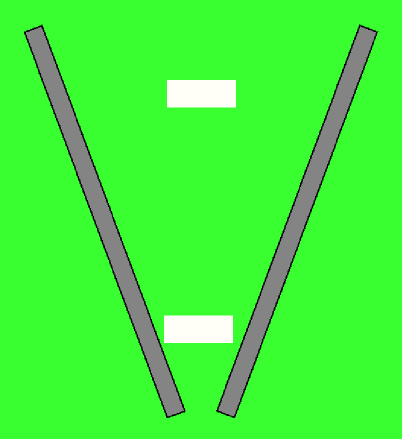
We see that the “enlarge effect” is similar to that in the picture of the railroad tracks, and that there is very little effect when the Etoys “tracks” are rotated outwards
More Inspiration
You can find the projects used in this chapter here: http://etoysillinois.org/library?sl=2145 and http://etoysillinois.org/library?sl=2146.
Try out more illusions like the ones you can find here: http://www.scientificpsychic.com/graphics/
Now that you know how to composite tiles, try the Steering The Car project from the Etoys gallery of projects.
Introduction
Etoys is a tile based programming environment for children that was built on Squeak by a team headed by Alan Kay. The child friendly design of the interface was influenced by the education theorist Seymour Papert, who many consider the driving force behind the use of computers in education. If you can use a mouse you can use Etoys.
A vision of Alan Kay and Seymour Papert is that all students should have the opportunity to imagine the future by exploring with the computer today. In many parts of the world that is now a reality. Their vision took on a global perspective in 2006 when Etoys was included on the XO machines in the OLPC project, that now number over 2.4 million around the world.
All school children should have the opportunity to engage with computers in the most meaningful way. Learning to think and using the computer to discover and work with powerful ideas is the knowledge of true value. The community of Etoys users is working toward the dream of having all students become computer literate.
This book only covers a small portion of those items. As you and your students learn some of the basic techniques, you will find more and more uses for them. The process of learning Etoys is just that, a process; the learning is on-going even though projects are begun and finished. Students will enjoy becoming experts and sharing their knowledge with others in the classroom.
Imagine this: A group of learners want to visualize what they Imagine so they go to Etoys to Invent their dreams and Inspire each other by building on their various Etoys projects. Today's learners need this kind of experience to be prepared for the future.
Etoys is supported by a large group of volunteers from all around the globe. If you would like to volunteer, or would like to reach one of the current volunteers, there are two websites you can visit:
http://www.squeakland.org/resources/community/
which contains links to Etoys groups around the globe and
< http://www.squeakland.org/contact/
where you can join the Etoys user mailing list. Please do join us.
How to Use this Book
This book is designed to lead the teacher on a learning path to Etoys. To begin you will need to go to http://squeakland.org and download Etoys. If you need help in downloading the software you can find further directions in the chapter titled Getting Help.
When you open Etoys you will see the following window:
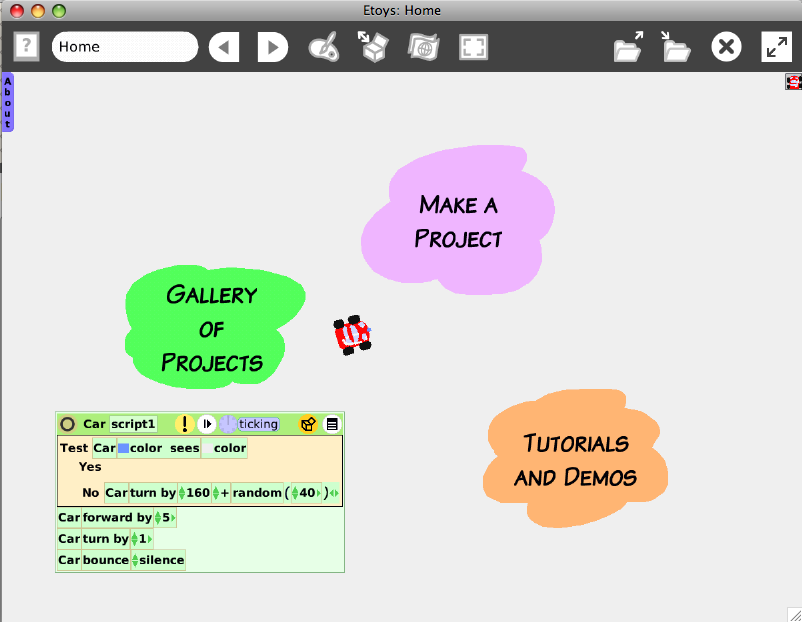
This book's chapters are arranged in a sequential way so that the Etoys knowledge needed builds from one chapter to the next. Idea, tools, tiles and techniques used in each chapter are listed at the beginning of the chapter. If, when looking through a chapter, you find things listed that are not explained in that chapter, you should look back over previous chapters to find when they were first introduced. At the end of each chapter there will be a section called "More Inspirations" which includes ways to enhance the project in the chapter and/or links to similar projects you might want to explore.
Throughout the chapters, there will be references to the built-in Quick Guide help. The Quick Guides are accessed by clicking the question mark icon on the far left side of the Navigation Bar at the top of all Etoys windows.
In Appendix A, Getting Help, there is more information on vocabulary and user tools which you may find helpful as you navigate through the book. Here you will also find links to online sites that have a wealth of information and sample projects.
In Appendix B, Quick Tips, you will find helpful information on loading and saving projects and other useful general knowledge.
Inventing Poetry in Motion
Imagine poetry illustrated and enriched with motion. Haiku is a small poetry form that is fun to use for Etoys projects. As you write your poem, be Inventive and imagine how your poem can be illustrated and made into a dynamic project. A poem that appeals to the eyes, the mind and a sense of humor may Inspire your reader to be creative too.
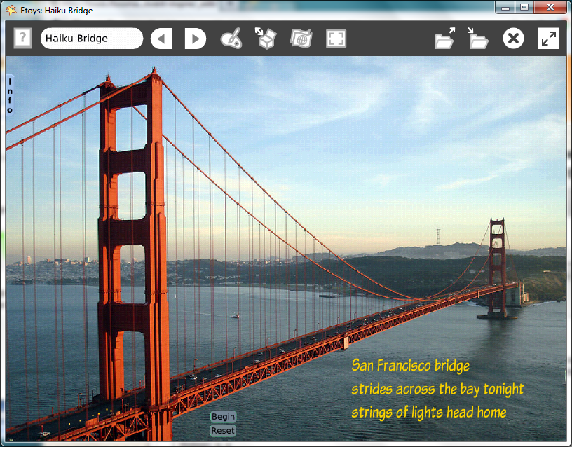
In this project we use:
Paint Tools, Halo Handles, Text, Digital Images, X and Y, Hide and Show, Tests Category, Normal Ticking, Button Fires a Script
The project also uses the Scripting category of tiles and they will be explained in the lesson.
Project
You may want to go to: http://etoysillinois.org/library?sl=2138 and view this project before beginning your own. The twinkling lights make the magic. The Haiku is by the author.
To begin, open Etoys and click on the cloud that says Make a Project.
Click on Supplies in the Navigator Bar and drag out a "Text". Text color, style and size can be modified by using the three icons across the lower edge of the text's halo. Try different fonts and sizes, choose a color with the magenta (eye drop) icon in the halo.
This project exercises your skills as an artist, a poet and a programmer. Like other artists, you are inventing a world where your ideas rule. Writing a Haiku takes a little specialized knowledge that you will need to think about before writing a poem. You could use a poem written by someone else, just be sure to give them credit as the author.
The project shown uses a digital image from the internet and the photographer's name is part of the project. Knowing how to find images on the internet and how to invent an object that connects the poem and the image is part of the fun of this project. One of the special features in Haiku is that the words match the image created.
If you have never written a Haiku, here is some basic information:
Haiku in English is a development of the Japanese haiku poetic form in the English language. Contemporary haiku are written in many languages.
It is impossible to single out any current style, format, or subject matter as definitive. Some of the more common practices in English include:
- Use of three lines of up to 17 syllables
- Use of a season word (kigo)
- Use of a cut or kire (sometimes indicated by a punctuation mark) to compare two images implicitly
You can read more about it here: http://en.wikipedia.org/wiki/Haiku_in_English
The poem in this project is:
San Francisco bridge
strides across the bay tonight
strings of lights head home
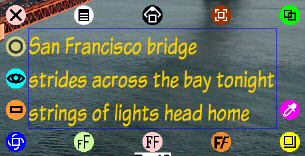
Once your poem is finished and edited to look the way you want, the next step is to select a Digital Image. Use a photograph you took or one you find on the internet. After you find an image you like, save it to a folder on your computer and then drag the photo from your folder into the open Etoys window. The size of the photo can be adjusted, bigger or smaller, by using the yellow Halo icon. Hold down the Shift key while dragging the yellow handle so the proportions will stay the same. Always give credit to the artist, author or photographer of materials you use in a project, even to yourself. Credits for the photo used in this project: Golden Gate Bridge Rich Niewiroski Jr. http://www.projectrich.com/gallery
The photo is a layer in the project and it should be the background. To make it stay in place, use the photo's halo white menu icon (top, second from left). Select all three options: be locked, resist being picked up, resist being deleted.
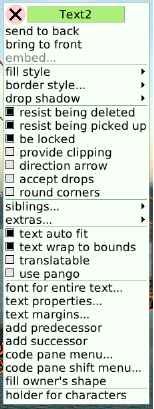
This poem's emphasis on the journey home led to using Paint Tools to make a drawing of little golden dots representing car headlights (named "string of lights"). The Paint Tools are also used to paint a set of small dots to represent the lights of homes (named "homes").
The string of lights on the bridge has the script below to make them travel: "x and y" are tiles in the Basic category. Drag both tiles and put them in one script. Click the small black arrow in each tile to open a menu of options that includes: increase by. Experiment with the numbers that make your drawing move at the best angle for your project's photograph. Name the script.
Open the Tests Category for the string of lights and put a test in your script. This project uses the "x" location to control when the car lights stop moving. They stop when x is greater than 1165. Open the homes viewer to find the "homes show" tile. This tile is located in the miscellaneous category.
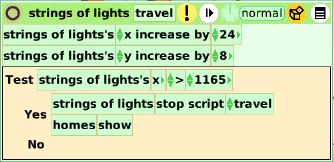
The lights of the homes "Hide and Show" tiles are in the same script for the car's lights. There is no need for a separate script.
The reset script will position the car's string of lights at a starting location that uses the "x and y" tiles. The reset script also is used to hide the home's lights. Since this project now has two scripts, you should name each script to indicate what they control. In this case "travel" and "reset"

As the author of an interactive art work you have a responsibility to the people who visit your project to make it ready for them. Throw away trash cans and other objects you do not want visitors to see. Correctly spelled words make a good impression. Click on the little tabs that open Viewer panes and collapse them so they are out of view of visitors. If everything looks right, save the project and share it.
More Inspirations
Photographs can be a source of inspiration for more Haiku, or sometimes a word or phase will lead to new ways to express yourself.
EtoysIllinois.org has a set of Haiku projects you may enjoy: http://etoysillinois.org/library?tags=Haiku
Quick Tips
Loading, Saving, Quitting
When you open Etoys, three clouds suggest places to start:
"Gallery of Projects" will take you to a selection of twenty-two projects that you can view and explore to learn some of the many things you can do with Etoys.
"Tutorials and Demos" will take you to three projects that will help you get started with learning Etoys.
"Make a Project" will bring you to a blank Etoys project page, where you can create and manipulate your own objects.
Loading
To load an existing project into your Etoys application, click the find-icon  in the navigation bar.
in the navigation bar.
If you click and hold the mouse button for several seconds, there will be a menu with more options for loading projects. These options differ in the places where you will look for the project and in the kind of files you can open. The first option "find a project" is the same that happens if you just click on the icon. It will open the default Etoys folder on your computer (or the folder on your USB drive if you are using Etoys-To-Go) to load your project. Here you can also choose "My Squeakland" and "Squeakland Showcase" to open a project directly from the Squeakland website. Keep in mind that you need internet access to do this!
The second option "find a project (more places)" lets you search throughout your whole directory structure.
The third option "find any file" allows you to load images into your project. The currently supported formats are .jpg and .png.
Saving
Once you have a project, you'll want to save it so that you can work on it again and pick up where you left off. Saving a project is different on the XO than it is on a Macintosh or Windows computer.
Saving to an XO
If you click the X on the top right corner of the menu bar, your XO will automatically save to the Journal. You will know it's saving because you'll see a stick figure doing jumping jacks.
To retrieve a saved file from the XO, click on the folder with the arrow pointing up. Choose the project you want to work on and it will load into Etoys. (It's a good idea to name your projects so that when you go back to work on them, you can distinguish them from one another.
Saving to a Macintosh or a Windows computer
Near the right corner of your Navigation Bar, you'll see the "Publish (save)" icon. 
When you are ready to save a project, click on the Publish icon, and you will see a screen waiting for you to "describe this project." You need to fill in a project name, and can optionally add a description, your name, and tags, too, then click OK.
The next screen you see shows options where you will be saving the project. You have two choices of places to save your project. Choose one and then click "save" to finish saving.
If you save to "Etoys" you are saving to your local computer, or to your USB drive if using Etoys to Go. It's a good idea to save locally until you feel you are ready to share your project. If you save to "My Squeakland" you will be saving to the Squeakland website, where you can choose to make your project public so that others can view it. You will need to create a Squeakland account if you want to save to My Squeakland. Login, and click "Save" to upload your project to the Squeakland website. Don't worry, Squeakland doesn't sell or rent your information.
Whether you choose to save to "My Squeakland" or to "Etoys" you will be able to retrieve and edit your project to make changes.
Quitting Altogether
To quit Etoys, simply click on the X on the top right of the navigation bar. You will be prompted with "Are you sure you want to quit Etoys?" Select Yes, and your Etoys window will disappear.
Caution, clicking on the X does not automatically save your work.
Using Viewers:
To open a viewer for an object: Open the halo for this object and click the "Open a Viewer for me" (eye-like) icon.
Each viewer has a small tab with the object image on its left side. A click on the tab will change the flap of the viewer status: from open to close; from close to open. The tab stays visible most of the times.
If you lost sight of the Viewer's tab, go back to this object's halo and reopen the Viewer from there.
Adding a tile to a script:
The tip of the cursor is the precise point of contact between the cursor arrow and any object in the Etoys world. This is useful when opening Halos and dragging tiles into their proper place in the script. If you are trying to place a tile somewhere and you cannot get the bright green "insertion place" to appear, it is probably because the tip of the cursor arrow is not positioned in the correct place.
The best way to drag non-assignment tiles is by their upper left corner.
Trash Can
Drag objects into the Trash Can to discard them. Double click on the Trash Can to open it and retrieve discarded objects from its inventory. If you don't make the Trash Can disappear, and don't explicitly empty the trash, you will be able to recover accidentally discarded objects.
Retrieving "lost" objects
When you can not find an object, one easy place to get information about it is in the Players object in the Supplies.
Drag the "Players" object from the Supplies into the world. It will open a list of all objects and a menu icon at the left of each items on the list. Click the menu icon of the lost object to get the needed information.
Ratios
Can you Imagine the gears turning in your mind as you read this? Try to imagine little gear's cogs meshing with a big gear's cogs. What does that look like? You can Invent your own system of gears. Inspire your classmates with your knowledge of gears.
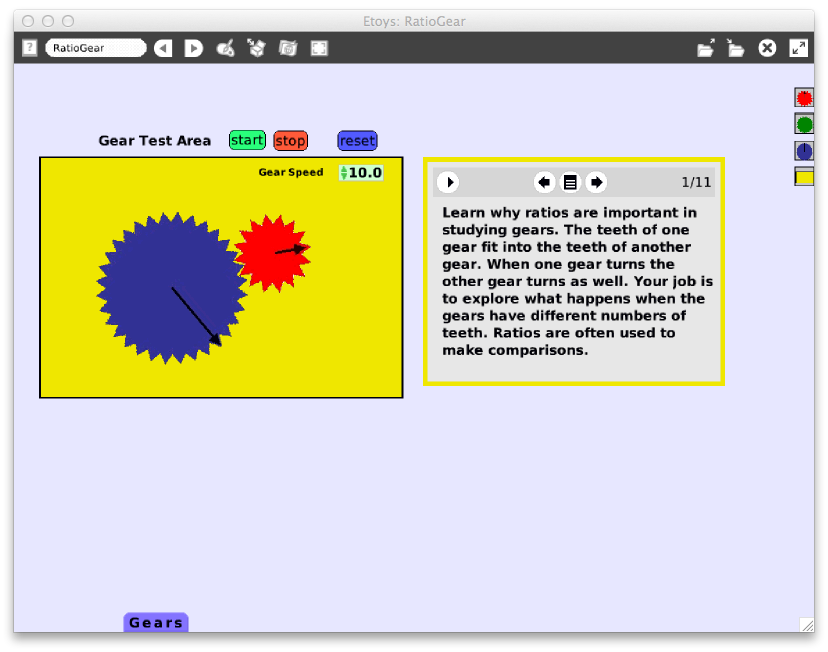
In this project we use:
text, book, buttons, test , Start Script, Stop Script, turn by, color sees
Project
Begin by downloading the project from http://etoysillinois.org/library?sl=2141.
Ratios are important in studying gears. The teeth of one gear fit into the teeth of another gear. When one gear turns the other gear turns as well. Your students can explore what happens when the gears have different numbers of teeth. Ratios are often used to make comparisons.
To start, they should
- click on the purple "Gears" flap at the bottom of the project to open it
- click on any gear and drag it into the yellow Gear Test Area, then click again to droo it into the yellow Gear Test Area
- repeat for a second gear
- put a tooth on one gear into a space between teeth on the other gear
- count the teeth in each gear and record in their notebook
To change the speed of the gears, they click on the Gear Speed number at the upper right of the Gear Test Area. It will be highlighted in darker green. Then type the new speed and press enter. You can also use the up and down arrows to change the gear speed. Have students set up a ratio to compare the number of teeth on the smaller gear to the number on the larger gear. Then they should:
- record the ratio in their notebook
- predict which gear will move faster
- record their prediction
- explain why they think this
- click start and count how many times the smaller gear turns when the other gear turns one complete turn
- click stop and reset when through
- calculate the ratio of the number of turns for the smaller gear to the number for the larger
- record the ratio in their notebook
They should repeat their experiment with other sets of two gears. There are six possibilities. Have them can list them. To do this methodically, they should start with the blue gear and list all combinations with it, then green and then red. You can give them this hint if they are stuck. Then they should record your results for the other five sets of gears.
Have them organize their data in a table to help them see relationships between the data for different gear sets. Ask them to ponder the following questions:
- What relationship can you find between the two ratios (teeth and turns) for each set?
- Does the smaller or larger gear turn faster?
- Can you explain your data?
Have your students try three gears, they will notice that one of the gears may turn the wrong way. Note that there are four different combinations of three gears. Have them try to write them down the combinations and test all the possibilities. Have them see if the can fix the problem by looking at my script. They can see my script by clicking the bottom yellow viewer tab at the upper right and dragging the "TestArea run" tile out onto the workspace. Challenge them to struggle to redesign the script to make all the gears always turn the correct direction.This will require more tests.
More Inspiration
Have your students
- think of some other uses of ratios - ratios are used by engineers and scientists
- look in their text books or on the Internet for ratio applications
- best of all think of some applications where they, their family or friends find ratios useful
- think up an idea for an application of gears
- search the Internet for information about their idea - someone may have thought of it
- make a presentation to the class using their data, observations, ideas and thoughts
Geoboards and Puzzling Polygons
Imagine kids constructing their own games, not just for themselves, but for others. Invent different shapes and use them to create puzzles. Inspire yourself to come up with new ways to engage with computer generated geometric puzzles.
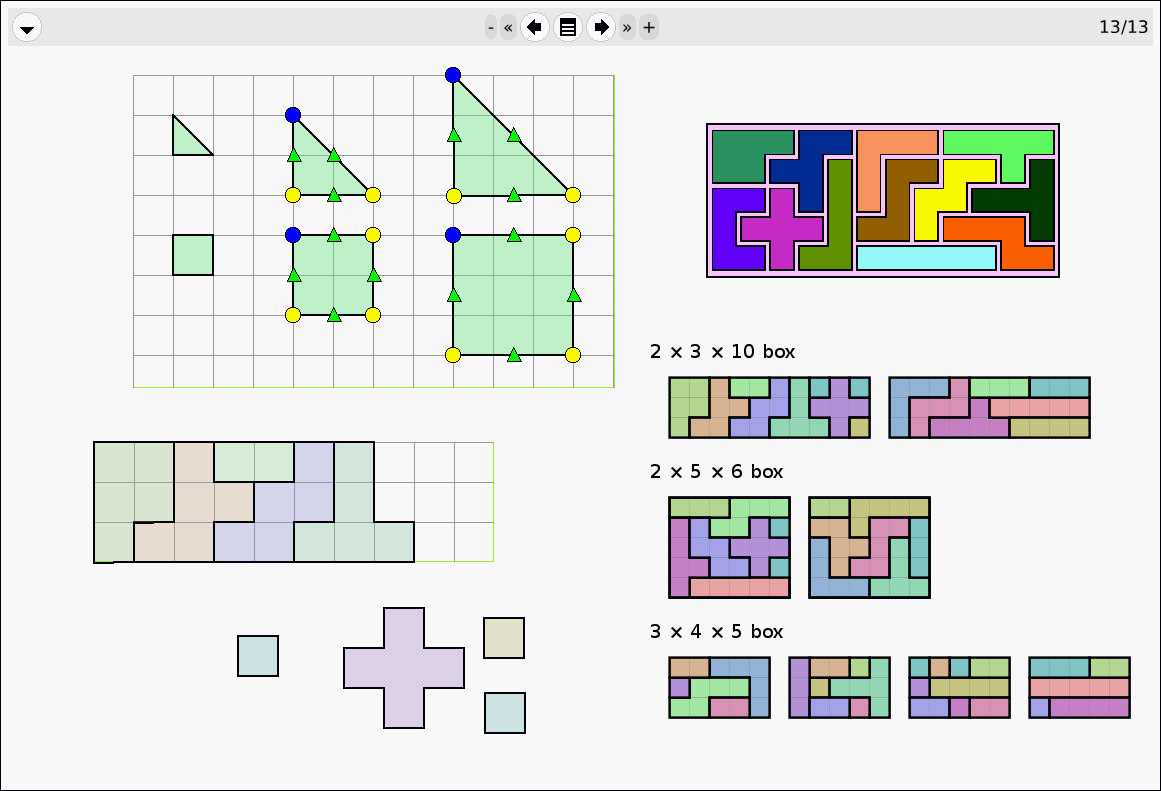
In this project we use:
Polygon, Gridded Playfield, color transparency (alpha), Halo - color icon (w/transparency)
The Project
A) Construct a Playfield with Gridding.
B) Create various shapes using an Etoys Polygon.
C) Use the Playfield and Polygons to build games and lessons.
To begin this project: Open Etoys and click on the cloud that says "Make a Project"
A) Construct a Playfield with Gridding
- Get a playfield from the Supplies

- From the white menu icon in the Playfield Halo select <playfield options...>

- From the playfield options menu check <grid visible when gridding> and <use gridding>
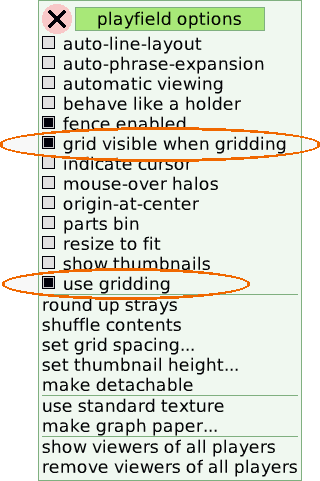
- Your playfield will now show gridlines
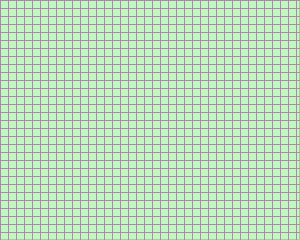
- Click on <set grid spacing> to specify the <grid origin> and <grid spacing>.
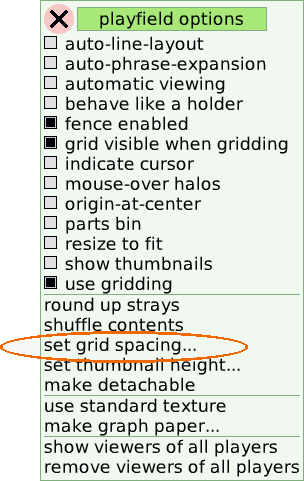
- The first dialog box allows you to specify the location of the origin within the playfield, for now 0@0 (which is the center of the playfield) is fine, simply click <Accept(s)>
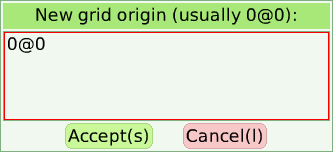
- The next dialog box allows you to specify the size of the grid in width (as measured along the X axis) and length (as measured along the y axis). For now enter 40@40 (40 wide and 40 long) then click <Accept(s)>

- Your playfield should now look like this:
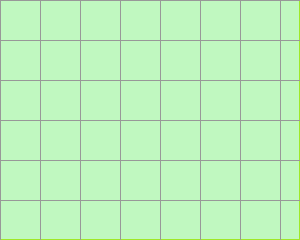
B) Create various shapes using an Etoys Polygon
- Get a Polygon from Supplies

- You can see the polygon's handles (aka vertices) by holding down the shift key while clicking on the polygon

- The circles (
 or
or  ) represent veritces you can drag to move.
) represent veritces you can drag to move.
- The blue circle (
 ) represents the "current vertex at cursor", don't worry about that for now, but if you want to play with it open the viewer and go to the polygon category. Then change the x at cursor, y at cursor and vertex cursor. Watch what happens and see if you can figure it out. This could be good for someone who finishes early.
) represents the "current vertex at cursor", don't worry about that for now, but if you want to play with it open the viewer and go to the polygon category. Then change the x at cursor, y at cursor and vertex cursor. Watch what happens and see if you can figure it out. This could be good for someone who finishes early.
- The green triangles (
 )allow you to create new vertices
)allow you to create new vertices
- Play around by moving the vertices (
 or
or  ), click and drag to move the vertices.
), click and drag to move the vertices.
- Try to create a square.
- Can you create a rectangle? What other shapes can you make?
- Now try creating a square by picking up the polygon and placing it inside a Gridded Playfield. Is it easier to make a square?
- Try to create a triangle. Notice what happens when you position one vertice almost exactly on top of another.
- Click to open the white menu icon in the Polygon's halo. Uncheck "closed" and see what happens

C) Use the Playfield and Polygons you created to build games and lessons
This section will describe how you can use the Playfields and Polygons to:
- Build your own Geoboard
- Build puzzles
Build your own Geoboard
By placing your Polygons on a Gridded Playfield you have virtual Geoboard for exploring ideas about area and permiter.
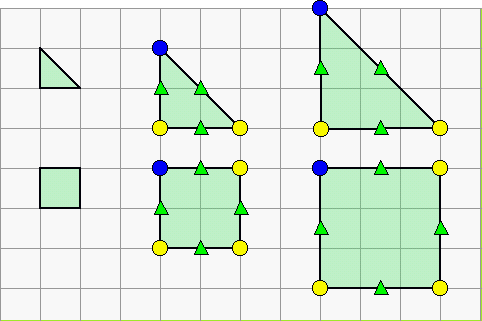
All you need to do is make your polygons transparent. This can be done by clicking on the Halo's "change color icon" ( ) then changing the transparency (as shown below)
) then changing the transparency (as shown below)
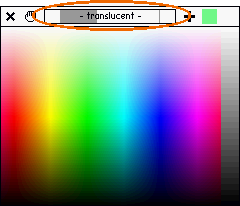
You can also change the transparency using the alpha tile in the color category of the Polygon viewer
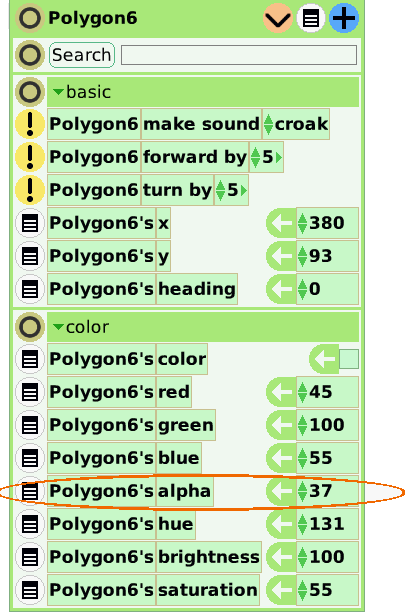
More Inspiration
Using these two simple tools: polygon and gridded playfield you can:
Build your own puzzles:
Pentominoes

Create your own "Broken Glass" Puzzles
Sample Broken Glass projects can be found at:
http://etoysillinois.org/library?tags=Broken%20Glass (see project images below).
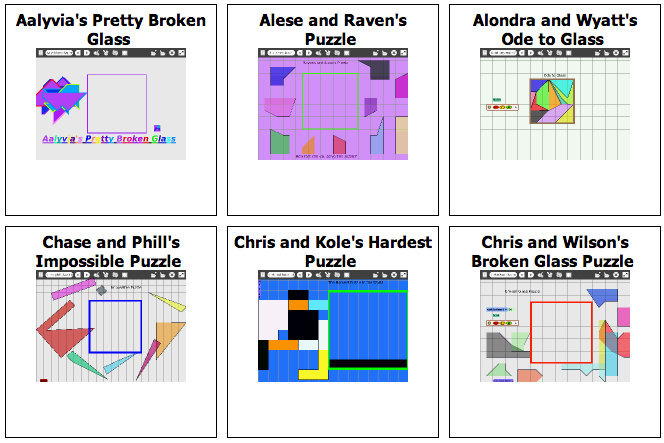
Tangram puzzles
Sample tangram projects created by kids can be found at: http://etoysillinois.org/search?q=tangram. Like the ones below:
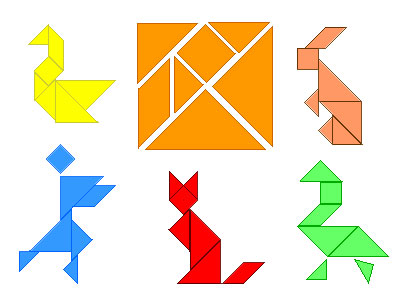
To learn more about certain objects or techniques used in this project check the folowing Quick Guides:
Halo -> Menu Tools
Object Catalog -> Polygon
Books -> (all items) Useful if you want to make a number of puzzles and put them in a book
Menus -> Grid and Snap to Grid
Tossing The Coin
Imagine what it would be like to toss a virtual coin. You will need to Invent a way to make your coin act like a real coin. It may Inspire you to design games and play.
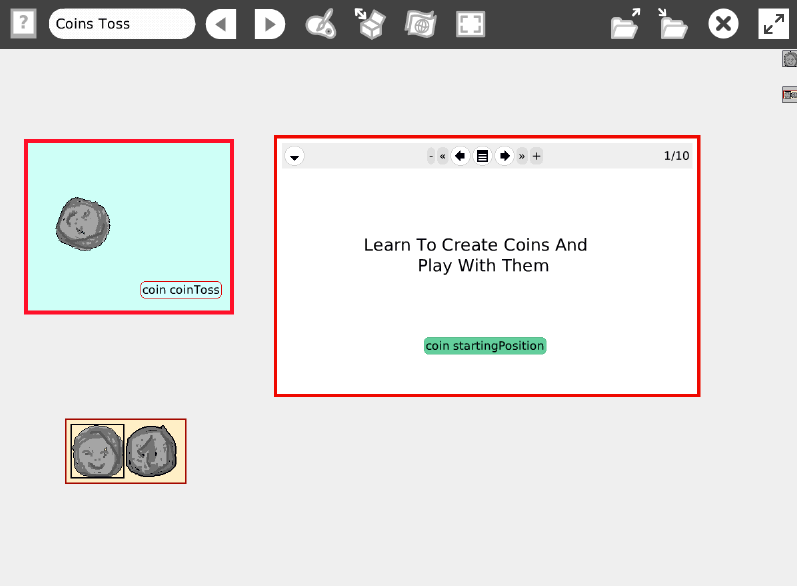
In this project we use:
Painted images, Holder, holder's viewer, "Holder's player at cursor"; Holder's cursor; compose a composite tile
Project
In this project, as in the Chapter 9 (Animation), we use one object (a coin) and change its look to mirror the images stored in an holder. We will 'toss' the coin and show how it falls; either heads or tails. In order for the coin to behave like a real one, the chance of falling on tails should be the same as the chance of falling on heads, but for any given toss we have no way to determine the exact result. Instead of increasing the holder cursor by one to move in a sequential order, (as we did in Chapter 9), we will use a random number generator available in Etoys and assign its results to the holder's cursor.
Instructions: Open Etoys and click on the cloud that says Make a Project.
1. Paint or import images of the 2 sides of a coin. Name these objects Head and Tail.
2. Put the tail and head objects in a holder (you find a holder in Supplies). Name the holder: coinsHolder.
.
3. Paint an object that will later change its look to mirror those of the images in the holder. A simple colored spot will do. Give this spot the name of the object it is going to mirror, e.g. "coin".
4. Open the spot's (coin's) viewer and open its graphics category. To do that, hold down the cursor on the word "basic" in the viewer and then move down the list and click to select "graphics" from the names that appear.
5. Drag the tile: "coin look like dot" out of the viewer and drop it. A Script Editor will open.
6. Open the holder's viewer.
7. Select the "collections" category (see #4 above) and find the tile "holder’s player at cursor". Drag and drop it to replace the box in the script where the word "dot" is (A green frame around the word "dot" will let you know you are in the right place). By doing this you have just told the spot of color (coin) to look like the image in the holder where the cursor is currently located. This will be the image in the boxed frame.
8. In the Holder's viewer, drag the tile: "holder's cursor <-- 1 by its white assignment arrow and add it to the script.
To simulate a tossing, randomly assign the holder's cursor a number from the group {1,2} by using random(2) function. You can find information about the use of the random function in the Quick Guides under Scripting Tiles.
Name the script: CoinToss1
The script for a coin toss will look like:

To simulate a visual change between two consecutive tosses, especially when there are two or more heads or tails in a row, one can add a small rotation to each toss. The "coin turn by" tile is found in the basic category of the coin viewer.
The improved script looks like this:

Here are 3 games you can play:
Coin Game 1* Two players take turns tossing a coin twice at each turn.
Player A wins when the result is two heads
Player B wins when the result is two tails.
Coin Game 2* Two players take turns tossing a coin three times in a turn.
The first player to get three heads in one turn wins.
Coin Game 3* Two players take turns tossing a coin three times in a turn
Player A wins if result of a turn is two tails and one head (order is not important).
Player B wins if the result of a turn is either all heads or all tails.
* Some of the games are not fair. They are designed so that one player is more likely to win than the other. Have the students discuss this.
Student's may also create their own games, some fair, some not.
This project, Coins Toss, can be found at: http://etoysillinois.org/library?sl=2132
More Inspiration:
This project could enable you to create visualizations for other events for which we know the probability. This type of event could include dice throwing events, simulations of infection disease spread and other questions of chance such as the probability of pulling a pair of matching socks out of a drawer.
Here is a project that uses a holder and a random number generator to simulate a Number-Cube throw and added games: Coins and Dice Games http://etoysillinois.org/library?sl=1531
Here is a project to illustrate and solve a probability question: Tale of Two Sons http://etoysillinois.org/library?sl=1952&viewProject
Water Cycle
Have you ever thought about the concept of a cycle? I'll bet you can Imagine words that you think represent cycles. That's a good way to start understanding a new concept. From there go on to the water cycle. You could Invent a simulation for parts of the water cycle to deepen your understanding. Inspire your classmates by showing them your simulations and critiquing theirs.
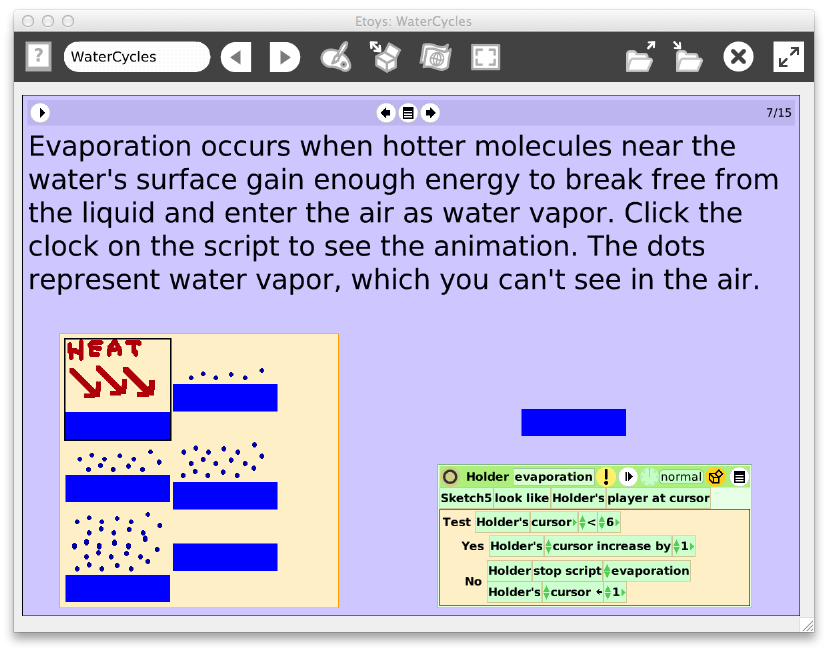
In this project we use:
text, holder, book, Holders Cursor, Forward by, Start Script, Stop Script, Test, Look Like, increase by, arithmetic , animation
Project
Begin by downloading the project from http://etoysillinois.org/library?sl=2139.
It is very likely learners will come across the water cycle. They can explore the water cycle in an interactive way and animate water raining from a cloud, the condensation process and another part of the water cycle.
To develop a deep understanding of a new concept like cycle, it can be helpful to come up with examples of the new concept and look for a common thread. Have your students access their imaginations and come up with examples of cycles. As they imagine harder and probe their minds, they should eventually come up with several parts of the water cycle. A picture containing parts of the water cycle with no captions is available for them to look at and extract parts of the water cycle. This takes some imagination.
A cycle is an action that repeats itself. Have your learners break up into small groups and brainstorm to come up with words or phrases that contain the word cycle and have them record their phrases in the Etoys project book (page 1).
After the learners have had time, ask them to report what phrases they have. Then click on the right arrow at the top of the book to proceed to the next page to see if they came up with phrases (words) like bicycle, tricycle, motorcycle, recycle, life cycle, business cycle.
Have students show their words to other groups and discuss what makes them cycles. Have them record a final definition of cycle. A cycle has parts that go round and round and repeat themselves. Did they come up with that?
If any of your groups came up with water cycle, they are good. Have them look at the drawing and write down things that are actions involving water. They can go to page 4 if they are stuck where they will find that water forming clouds is a water action. Ask them to find more water actions and record their answer.
Water forms clouds when it evaporates from bodies of water. When the clouds produce rain or snow, the water is returned. That's part of the water cycle. Have the learners discuss how the actions they identified are part of the water cycle.
Here are some of the parts of the water cycle: evaporation, condensation, precipitation, runoff, infiltration, ground water flow, evapotranspiration, snow and ground water storage. It is a good exercise for learners to look up names they don't know. How many of these did your students identify?
Evaporation occurs when hotter molecules near the water's surface gain enough energy to break free from the liquid and enter the air as water vapor. Heat provides the energy needed. The dots represent water vapor, but they are way too big. You can't see water vapor in the air. Have your students play with the script on page 7 to view the animation and understand how the script works so they can invent their own and develop an even deeper understanding of the water cycle.

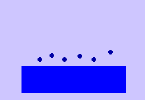

They should try an animation showing water raining from a cloud (precipitation) and create it on page 9 of the Etoys project. Finally, they should make an animation showing another part of the water cycle and create it on page 11 of the Etoys project. As they work on these animations they should be able to inspire one another with their great ideas.
On page 15 of the Etoys project, there is a more complete picture of the water cycle. Have your students discuss the various actions of water in the water cycle and how this picture represents a cycle.
More Inspiration
Have you ever seen dew on grass in the morning? That is water vapor condensing out of the air onto the grass because it was cold enough overnight. Clouds are made the same way, except the water vapor condenses on tiny, invisible particles in the cooler air high above. As more water vapor condenses on the same drop, the droplet finally becomes visible. Have your learners work in groups to inspire each other to animate condensation. This is harder to do so inspirational ideas from each group member will result in a better project. Have them put the project they invent on page 14 of the Etoys Water Cycles project.




























 at the bottom of each page.
at the bottom of each page.

 or
or 




























 Additional Resources:
Additional Resources:



















 in the navigation bar.
in the navigation bar.












 or
or  ) represent veritces you can drag to move.
) represent veritces you can drag to move.
 )allow you to create new vertices
)allow you to create new vertices

 ) then changing the transparency (as shown below)
) then changing the transparency (as shown below)











